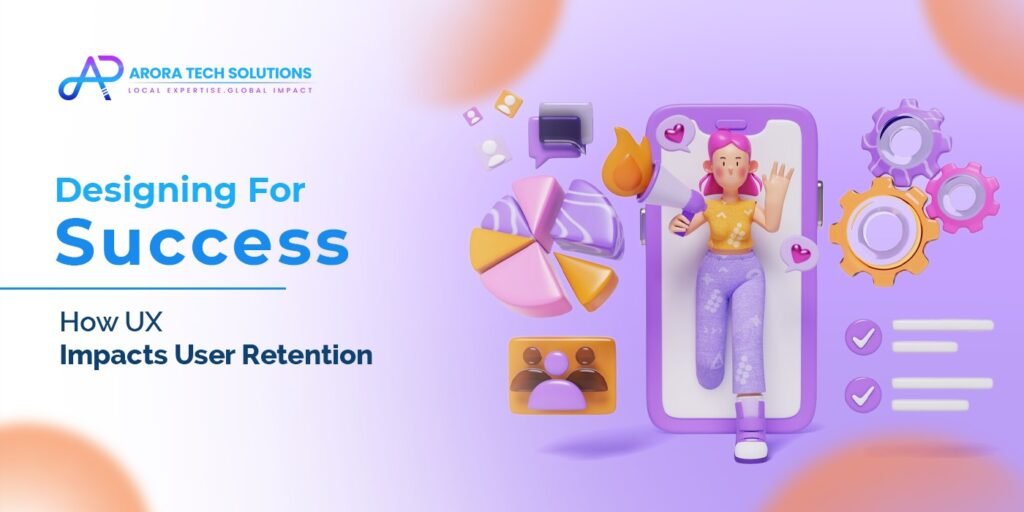Designing for Success: How UX Impacts User Retention
Designing for Success: How UX Impacts User Retention
In the competitive world of digital products, creating a memorable user experience (UX) is not just a luxury—it’s a necessity. The success of your website, app, or platform largely depends on how users perceive and interact with it. A well-designed UX can make all the difference in attracting users and keeping them engaged over time. In this blog, we’ll explore how UX directly impacts user retention and why investing in a seamless and intuitive user experience is essential for long-term success.
What is UX Design?
UX design refers to the process of designing a product with the user’s needs, behaviors, and emotions in mind. It goes beyond the visual design of an interface to encompass the entire experience a user has when interacting with a product or service. This includes factors such as ease of use, accessibility, performance, and overall satisfaction.
Good UX design ensures that users can navigate your product effortlessly, find what they need quickly, and enjoy a pleasant, frictionless experience. When done right, it builds trust, encourages users to return, and increases the likelihood of them recommending your product to others.

Why UX Design Matters for User Retention
User retention is the ability to keep users engaged with your product over time. It’s a key metric for any business, as retaining customers is often more cost-effective than acquiring new ones. Here’s how UX directly influences user retention:
1. Seamless Navigation Reduces Friction
A smooth and intuitive user journey is critical for retaining users. If users encounter confusion or frustration while navigating your website or app, they’re more likely to abandon the experience.
- Clear Information Architecture: A well-organized structure ensures users can find what they’re looking for quickly without unnecessary clicks or confusion.
- Easy Navigation: Simple, easy-to-understand menus, buttons, and labels guide users through your site or app without overwhelming them.
When users can effortlessly move through your product, they are more likely to come back because they know it’s easy to use.
2. Fast Loading Speeds Enhance Satisfaction
Nothing frustrates users more than slow-loading pages or apps. Research shows that users tend to abandon websites or apps if they take more than a few seconds to load. Slow speeds create a poor user experience and leave users feeling impatient or dissatisfied.
- Optimized Performance: By focusing on improving load times, your product will be more user-friendly, leading to better retention rates.
- Mobile Optimization: As mobile usage grows, ensuring that your site or app is optimized for mobile devices becomes crucial for user retention.
Fast performance ensures users don’t have to waste time waiting, making them more likely to stick around.
3. Personalization Keeps Users Engaged
A personalized experience can significantly impact user retention by making users feel valued and understood. UX design should aim to tailor the user experience based on individual preferences, behaviors, and past interactions.
- Customizable Interfaces: Allow users to personalize aspects of their experience, such as themes, layout, or content recommendations.
- Relevant Content: By offering content that aligns with their interests or behavior, you create a more engaging experience that keeps users coming back for more.
Personalization shows users that you understand their needs, encouraging long-term engagement.
4. Visual Appeal Builds Trust
The visual design of your product plays a key role in creating a positive first impression. A clean, modern, and aesthetically pleasing design can make users feel more comfortable and confident in using your product.
- Consistent Branding: A consistent visual identity throughout your website or app fosters trust and reliability. Colors, typography, and imagery should align with your brand values.
- Intuitive Layout: The placement of key elements should be clear and logical, making it easy for users to understand how to interact with your product.
When users feel comfortable with the design and can quickly understand how to use your product, they are more likely to stay loyal to your brand.
5. Accessibility Ensures Inclusivity
Ensuring your product is accessible to users with disabilities is not just the right thing to do; it also contributes to higher retention. Accessible UX design ensures that everyone, regardless of their physical abilities, can engage with your product.
- Clear Fonts and Contrast: Make sure text is readable with sufficient contrast between background and text.
- Keyboard Accessibility: Ensure that all functions can be accessed using a keyboard for users with motor impairments.
- Screen Reader Compatibility: Implement screen readers for visually impaired users, so they can navigate your product seamlessly.
An accessible product is a user-friendly product, and when users can easily interact with it, they’re more likely to stay engaged.
6. Ongoing Support Builds Customer Loyalty
Great UX doesn’t end with a user’s first interaction. Continuous support is key to maintaining long-term engagement. Offering easily accessible help options like FAQs, live chat, and support tickets can ensure that users feel supported and confident in their use of the product.
- Self-Service Support: Provide users with the tools they need to solve issues on their own, such as knowledge bases or chatbots.
- Responsive Customer Support: Ensure your support team is quick to respond to users’ queries and complaints, improving their overall experience with your brand.
By offering ongoing support, you reassure users that they can rely on you, which can increase user retention and loyalty.
How to Measure UX Impact on Retention
To assess how UX design is influencing user retention, it’s important to track relevant metrics:
- Bounce Rate: High bounce rates may indicate that users are not satisfied with the user experience and are leaving quickly.
- Session Duration: Longer session times suggest users are engaged and find your product useful.
- User Feedback: Collecting and analyzing user feedback, whether through surveys, reviews, or usability testing, can help identify pain points that affect retention.
- Churn Rate: Monitoring how many users stop using your product over time can help gauge if UX issues are driving them away.
By keeping track of these metrics, you can pinpoint areas for improvement and refine your UX design to enhance user retention.
Conclusion
User retention is critical to the long-term success of any digital product, and UX plays a crucial role in achieving it. By focusing on creating a seamless, fast, personalized, and visually appealing experience, you can encourage users to return to your product and stay engaged. With ongoing support and accessibility, you’ll not only retain users but also build trust and loyalty, ensuring that your product stands out in a competitive digital landscape.
Investing in UX design is an investment in user satisfaction and, ultimately, in the success of your business.


